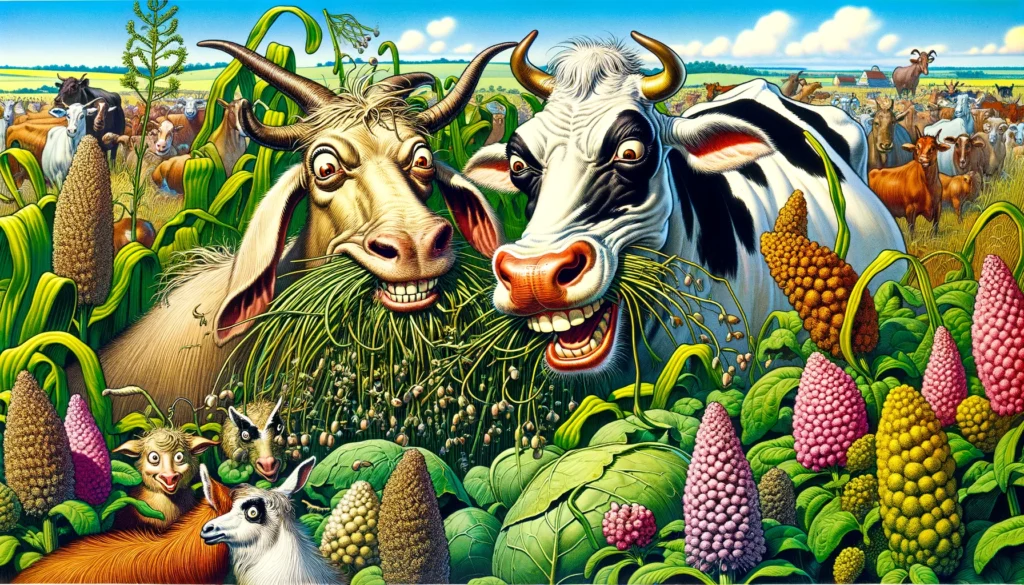
Forage refers to edible plant materials such as grasses legume A detailed close up illustration focusing on a section of the previous pastoral scene. The image features a cow and a go.webp.webp
Forage
Definition:
Forage refers to edible plant materials, such as grasses, legumes, herbs, or shrubs, grazed or consumed by livestock animals for nutrition, sustenance, or dietary requirements in agricultural ecosystems. Forages are essential components of ruminant diets, providing sources of fiber, protein, energy, vitamins, and minerals necessary for rumen fermentation, digestion, and metabolic functions in cattle, sheep, goats, and other herbivorous animals.
Description:
Forage production and utilization are integral parts of sustainable livestock farming, pasture management, and rangeland ecosystems, supporting animal nutrition, soil fertility, biodiversity conservation, and ecosystem services in agricultural landscapes. Forages are cultivated as permanent pastures, hayfields, or forage crops, comprising a diverse mix of grass species, legumes, clovers, alfalfa, trefoil, chicory, brassicas, and other forage plants adapted to local climates, soils, and environmental conditions.
Fall off the barn roof and busted your keister? Life on the farm or ranch can be tough on the bum. Need a break? Laugh it off at FarmerCowboy.com, the #1 farm humor site. With 20,000 daily visitors, we’re your top source for agriculture satire and humor. Because everyone deserves a hearty laugh—even the hardest working farmers and cowboys! Join us and turn those long days into fun tales at FarmerCowboy.com.
Types of Forage:
Forages can be categorized into several types based on their botanical composition, nutritional value, and agronomic characteristics, including:
- Grass Forage: Forage made from grass species such as ryegrass, fescue, orchardgrass, timothy, bermudagrass, or prairie grasses, providing sources of roughage, fiber, and energy for ruminant diets in grazing systems, haymaking operations, or silage production.
- Legume Forage: Forage made from leguminous plants such as alfalfa, clover, birdsfoot trefoil, or vetch, which offer higher protein, calcium, and mineral content compared to grasses, enhancing forage quality, palatability, and nutrient density in ruminant diets.
- Mixed Forage: Forage made from a combination of grasses and legumes, providing a balanced blend of fiber, protein, energy, and nutrients for livestock nutrition, improving pasture productivity, soil fertility, and animal performance in mixed-species grazing systems.
- Browse Forage: Forage made from browse plants, shrubs, or trees, such as willow, poplar, mulberry, or mesquite, utilized by livestock as alternative sources of forage, browse, or woody biomass in extensive grazing, agroforestry, or silvopastoral systems.
Uses of Forage:
Forage serves several purposes and applications in livestock production, including:
- Grazing: Forage is grazed or consumed by livestock animals in pasture-based systems, rotational grazing, strip grazing, or intensive grazing management schemes, providing continuous access to fresh, nutritious forage resources for cattle, sheep, goats, or horses.
- Haymaking: Forage is harvested, dried, cured, and baled as hay for winter feed, stored as haylage or silage forage forage preservation, or utilized as stockpiled forage for emergency feed supplies, ensuring year-round access to forage resources and maintaining animal health, productivity, and performance.
- Silage Production: Forage crops are chopped, ensiled, and fermented as silage for livestock feed, providing high-moisture, high-energy forage sources for dairy cows, beef cattle, or other ruminant animals in silage-based feeding systems during periods of limited pasture availability, seasonal droughts, or winter months.
- Forage Conservation: Forage conservation techniques, such as haymaking, silage-making, or forage drying, minimize forage spoilage, degradation, or nutrient loss during storage, transportation, or feeding operations, optimizing forage quality, feed value, and feed efficiency in livestock production systems.
Conclusion:
Forage production and utilization play crucial roles in sustainable livestock farming, supporting animal nutrition, health, and performance while promoting soil fertility, biodiversity, and ecosystem resilience in agricultural landscapes. By integrating forage-based feeding systems, pasture management practices, and conservation strategies, farmers can enhance forage productivity, optimize animal welfare, and improve agricultural sustainability in livestock production systems.
References:
- Bélanger, G., et al. (2018). Forage agronomy. In Forages: The Science of Grassland Agriculture (7th ed., pp. 1-33). John Wiley & Sons.
- Moore, K. J., & Jung, H. J. G. (2017). Forage quality measurements. In Forages: The Science of Grassland Agriculture (7th ed., pp. 265-287). John Wiley & Sons.
- Smith, J. E., et al. (2019). Forage preservation and feeding. In Forages: The Science of Grassland Agriculture (7th ed., pp. 289-328). John Wiley & Sons.
Originally posted 2017-02-25 17:11:48.
Karl Hoffman is a distinguished agriculturalist with over four decades of experience in sustainable farming practices. He holds a Ph.D. in Agronomy from Cornell University and has made significant contributions as a professor at Iowa State University. Hoffman’s groundbreaking research on integrated pest management and soil health has revolutionized modern agriculture. As a respected farm journalist, his column “Field Notes with Karl Hoffman” and his blog “The Modern Farmer” provide insightful, practical advice to a global audience. Hoffman’s work with the USDA and the United Nations FAO has enhanced food security worldwide. His awards include the USDA’s Distinguished Service Award and the World Food Prize, reflecting his profound impact on agriculture and sustainability.


